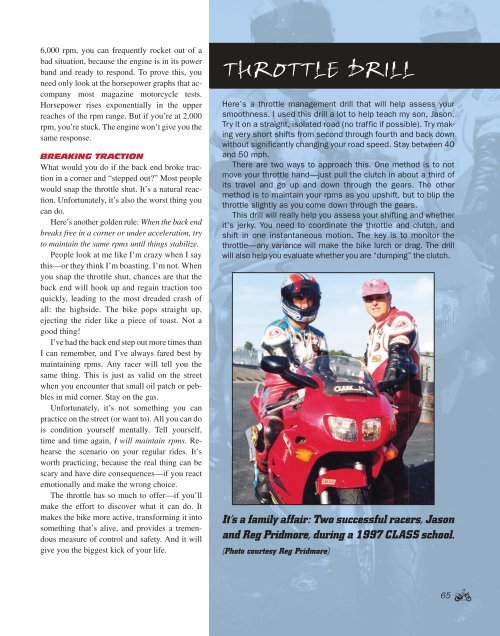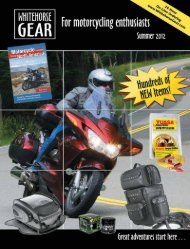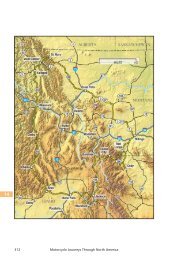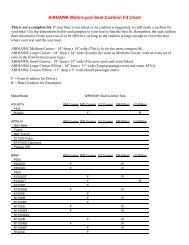THROTTLE MANAGEMENT - Whitehorse Gear
THROTTLE MANAGEMENT - Whitehorse Gear
THROTTLE MANAGEMENT - Whitehorse Gear
- No tags were found...
You also want an ePaper? Increase the reach of your titles
YUMPU automatically turns print PDFs into web optimized ePapers that Google loves.
6,000 rpm, you can frequently rocket out of abad situation, because the engine is in its powerband and ready to respond. To prove this, youneed only look at the horsepower graphs that accompanymost magazine motorcycle tests.Horsepower rises exponentially in the upperreaches of the rpm range. But if you’re at 2,000rpm, you’re stuck. The engine won’t give you thesame response.BREAKING TRACTIONWhat would you do if the back end broke tractionin a corner and “stepped out?” Most peoplewould snap the throttle shut. It’s a natural reaction.Unfortunately, it’s also the worst thing youcan do.Here’s another golden rule: When the back endbreaks free in a corner or under acceleration, tryto maintain the same rpms until things stabilize.People look at me like I’m crazy when I saythis—or they think I’m boasting. I’m not. Whenyou snap the throttle shut, chances are that theback end will hook up and regain traction tooquickly, leading to the most dreaded crash ofall: the highside. The bike pops straight up,ejecting the rider like a piece of toast. Not agood thing!I’ve had the back end step out more times thanI can remember, and I’ve always fared best bymaintaining rpms. Any racer will tell you thesame thing. This is just as valid on the streetwhen you encounter that small oil patch or pebblesin mid corner. Stay on the gas.Unfortunately, it’s not something you canpractice on the street (or want to). All you can dois condition yourself mentally. Tell yourself,time and time again, I will maintain rpms. Rehearsethe scenario on your regular rides. It’sworth practicing, because the real thing can bescary and have dire consequences—if you reactemotionally and make the wrong choice.The throttle has so much to offer—if you’llmake the effort to discover what it can do. Itmakes the bike more active, transforming it intosomething that’s alive, and provides a tremendousmeasure of control and safety. And it willgive you the biggest kick of your life.Here’s a throttle management drill that will help assess yoursmoothness. I used this drill a lot to help teach my son, Jason.Try it on a straight, isolated road (no traffic if possible). Try makingvery short shifts from second through fourth and back downwithout significantly changing your road speed. Stay between 40and 50 mph.There are two ways to approach this. One method is to notmove your throttle hand—just pull the clutch in about a third ofits travel and go up and down through the gears. The othermethod is to maintain your rpms as you upshift, but to blip thethrottle slightly as you come down through the gears.This drill will really help you assess your shifting and whetherit’s jerky. You need to coordinate the throttle and clutch, andshift in one instantaneous motion. The key is to monitor thethrottle—any variance will make the bike lurch or drag. The drillwill also help you evaluate whether you are “dumping” the clutch.It’s a family affair: Two successful racers, Jasonand Reg Pridmore, during a 1997 CLASS school.(Photo courtesy Reg Pridmore)65















